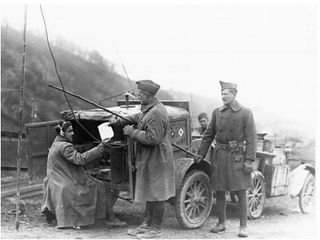The Science of World War I: Communications

World War I is frequently referred to as "the first modern war," since a number of technological inventions made their debut during the war, which lasted from 1914 to 1918.
Nowhere was this more true than in the realm of communications — the recent introduction of electricity- and radio-based communications revolutionized the art of war, joining other advances such as military airplanes, tanks, machine guns and chemical weapons.
Despite these new technologies, many military leaders were slow to take advantage of them and continued to wage war as if it were a cavalry-based affair. Their reluctance (or inability) to adapt to new methods of warfare has been cited as one reason World War I was such a bloody affair, resulting in more than 17 million civilian and military deaths. [Photos: The Great War: World War I, 1914-1918]
Electricity and war communications
Historically, warfare was a daytime endeavor, but that began to change in 1879, when Thomas Edison filed a patent for a long-lasting electric light bulb. By the time World War I began, electricity was in use worldwide (though it was still not as common as it is today).
For the first time ever, military leaders were able to conduct mass troop movements and launch large-scale invasions using artificial light. Virtually every mechanized contraption — battleships, tanks, airplanes, cars and trucks, radio devices — could be powered or enhanced by electricity.
Consider, for example, battleships: Electricity allowed them to use safe, precise electric signaling lamps (in lieu of flares or flames) to communicate with onshore commanders and with other ships. Electricity could also be used onboard to operate guns and turrets, fuel and water gauges, whistles, fire alarms and remote controls of bulkhead doors and other mechanisms.
Sign up for the Live Science daily newsletter now
Get the world’s most fascinating discoveries delivered straight to your inbox.
Electric searchlights using high-intensity arc lamps also changed warfare, from both offensive and defensive perspectives. Brilliant searchlights — bright enough to blind enemy troops — helped torpedo boats get closer to the ships they attacked. Searchlights were also used to spot enemy warplanes, which were starting to be employed to bomb cities, ports and factories.
"Every army engaged in the titantic struggle in Europe, from the smallest to the largest, is plentifully supplied with mobile searchlight equipments that can be posted at any spot," Scientific American reported in 1915.
"In the more improved forms of transportable searchlights," the report added, "the projectors are fitted with a remote control system so that the attendant, standing perhaps 20 or more feet distant, can, by means of a small control board held in the hands, direct and alter the beams. Thus, he is not blinded by the terrific glare of the rays, which would be the case were he standing close to the projector. Many of the portable projectors have a range of 5 miles or more."
Wartime radio
Radio made its debut years before World War I — it was often used by ships transmitting messages via Morse code, and in 1912, operators on the Titanic depended on radio to communicate with other ships and with onshore radio stations.
The biggest improvements radio offered over message systems like Morse code were the speed and accuracy afforded by the use of voice communication. Advances in radio technology such as oscillators, amplifiers and the electron tube made reliable voice communication possible. [7 Technologies That Transformed Warfare]
The "wireless" (as early radio was sometimes called) quickly proved invaluable to wartime efforts: Radio operators with portable transmitters, for instance, were able to warn soldiers of an attack of poisonous gas, giving them time to don their gas masks.
The German army used radio transmissions to guide dirigibles making bombing runs, and radio proved indispensible to communication with another recent development: airplanes.
The dogs and birds of war
Despite these advances in electronics and communications, the devices were sometimes unreliable in the heat of battle, so some military units preferred — or were forced to — rely on older, tried-and-true methods of staying in touch.
Pigeons were used frequently by British and French commanders to communicate with headquarters. In fact, Great Britain passed a regulation making it a crime to molest, wound or kill any homing pigeon.
"£5 Reward will be paid by the National Homing Union for information leading to the conviction of any person shooting homing pigeons on the property of its members," read one wartime poster.
Trained dogs were also used as messengers — they were faster than humans, presented a smaller target to enemy snipers and could speed down muddy roads and dirt paths that were impassable to vehicles. A military dog-training school was established in Scotland during World War I; one graduate of the school reportedly delivered a message across 3 miles (4.8 km) of battle-scarred terrain when all other means of communication failed.
Dog messengers, however, had one disadvantage: Beleaguered soldiers often befriended the dogs and, rather than send their beloved animal companions on dangerous missions, would carry the messages instead, leaving the dogs safely behind.
Follow Marc Lallanilla on Twitter and Google+. Follow us @livescience, Facebook & Google+. Original article on Live Science.

